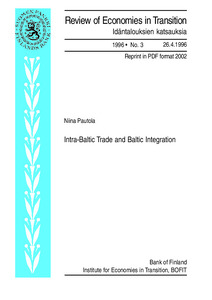Intra-Baltic trade and Baltic integration
Pautola, Niina (26.04.1996)
Numero
3/1996Julkaisija
Suomen PankkiBank of Finland
1996
Julkaisun pysyvä osoite on
https://urn.fi/URN:NBN:fi:bof-201408113075Tiivistelmä
Up to the end of 1991, more than 90 % of Baltic trade was conducted with other parts of the Soviet Union, where trade was organized not on the basis of voluntary exchange but strictly guided by Moscow.The subsequent collapse of central planning caused widespread disruption in trade and financial links. Nevertheless, the Baltic countries, to a certain extent, retained their strong dependence on trade with Russia and other states of the former Soviet Union, and as a result saw their terms of trade decrease by 10-15 % of GDP.Further, they experienced high inflation, dramatic output declines, shortages of goods and raw materials, and dysfunctional payment and monetary arrangements.To correct this situation and avoid prolonged economic difficulties, Baltic trade links with the West were restored, as well as economic relations among the Baltic nations themselves. From the trade policy point of view, Estonia followed the most liberal course by eliminating trade restrictions altogether. Latvia and Lithuania have favoured more protectionist policies. Estonia and Latvia have consistently strived to boost their trade with the West, while Lithuania still maintains stronger trade relations with Russia. Despite the fact that the Baltic countries have a free trade agreement and numerous actions have been taken to promote intra-Baltic trade links, current problems at macro- and microeconomic level as well as trade policy differences constitute major obstacles to trade creation and greater cooperation among the Baltic states.Further, the smallness of the Baltic market and the general sameness of tradeable products tend to limit the possibilities for intraregional trade.As a consequence, growth in intraregional trade has remained quite modest. Keywords: foreign trade, integration, Baltic countries
Julkaisuhuomautus
Uudelleenjulkaistu pdf-muodossa 2002 (Idäntalouksien yksikön sarja)Reprint in PDF format 2002 (Unit for Eastern European Economies series)
